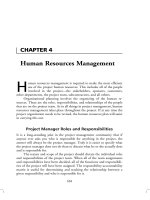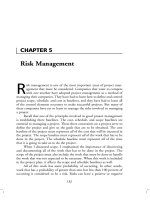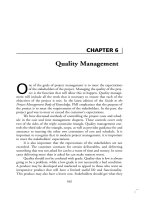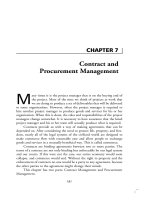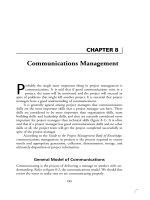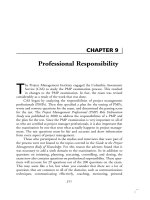Tài liệu PROJECT MANAGEMENT STEP BY STEP ppt
Bạn đang xem bản rút gọn của tài liệu. Xem và tải ngay bản đầy đủ của tài liệu tại đây (2.61 MB, 304 trang )
P
ROJECT
M
ANAGEMENT
S
TEP
-
BY
-S
TEP
P
ROJECT
M
ANAGEMENT
S
TEP
-
BY
-S
TEP
Larry Richman
American Management Association
New York • Atlanta • Brussels • Buenos Aires • Chicago • London • Mexico City
San Francisco • Shanghai • Tokyo • Toronto • Washington, D.C.
Special discounts on bulk quantities of AMACOM books are
available to corporations, professional associations, and other
organizations. For details, contact Special Sales Department,
AMACOM, a division of American Management Association,
1601 Broadway, New York, NY 10019.
Tel.: 212-903-8316. Fax: 212-903-8083.
Web site: www.amacombooks.org
This publication is designed to provide accurate and authoritative
information in regard to the subject matter covered. It is sold with the
understanding that the publisher is not engaged in rendering legal,
accounting, or other professional service. If legal advice or other expert
assistance is required, the services of a competent professional person
should be sought.
‘‘PMI’’ is a service and trademark of the Project Management Institute,
Inc., which is registered in the United States and other nations. ‘‘PMP’’
is a certification mark of the Project Management Institute, Inc., which
is registered in the United States and other nations. ‘‘PMBOK’’ is a
trademark of the Project Management Institute, Inc., which is
registered in the United States and other nations.
Library of Congress Cataloging-in-Publication Data
Richman, Larry.
Project management step-by-step / Larry Richman.
p. cm.
Includes bibliographical references and index.
ISBN 0-8144-0727-7
1. Project management. I. Title.
HD69.P75 R53 2002
658.4Ј04—dc21
2002001987
᭧ 2002 Larry Richman.
All rights reserved.
Printed in the United States of America.
This publication may not be reproduced,
stored in a retrieval system,
or transmitted in whole or in part,
in any form or by any means, electronic,
mechanical, photocopying, recording, or otherwise,
without the prior written permission of AMACOM,
a division of American Management Association,
1601 Broadway, New York, NY 10019.
Printing number
10987654321
This Page Intentionally Left Blank
To my wife,
Teri,
for her patience during the thousands of hours in
writing, editing, and refining the book
This Page Intentionally Left Blank
CONTENTS
Preface ix
Section 1: Preparing for Project Management Success 1
Chapter 1: Understanding the Importance of
Project Management 3
Chapter 2: Organizing for Project
Management Efficiency 15
Chapter 3: Defining the Roles of the Project
Manager and the Team 29
Chapter 4: Defining the Roles of Clients,
Customers, and Other
Stakeholders 44
Chapter 5: Setting Up a Planning and Control
System 49
Section 2: Planning the Project 57
Chapter 6: Defining the Project 59
Chapter 7: Creating a Work Breakdown Structure 75
Chapter 8: Estimating Activities 79
Chapter 9: Sequencing Activities 97
viii CONTENTS
Chapter 10: Calculating the Critical Path 107
Chapter 11: Preparing Schedules 116
Chapter 12: Preparing Resource Plans 123
Chapter 13: Preparing Budget Plans 130
Chapter 14: Getting Approvals and Compiling a
Project Charter 134
Chapter 15: Setting Up a Monitoring and
Control Process 138
Section 3: Executing the Project 147
Chapter 16: Initiating the Project 149
Chapter 17: Controlling Project Objectives 151
Chapter 18: Reporting on Project Objectives 171
Chapter 19: Controlling Changes in the Project 184
Chapter 20: Conducting Project Evaluations 189
Chapter 21: Managing Risk 194
Chapter 22: Closing the Project 203
Section 4: Leading the Project Team 209
Chapter 23: Developing Project Teams 211
Chapter 24: Managing Conflict 216
Chapter 25: Communicating Effectively 221
Chapter 26: Holding Effective Meetings 231
Chapter 27: Making Team Decisions 237
Chapter 28: Using Sources of Power Wisely 241
Chapter 29: Managing Change 247
Chapter 30: Managing Performance 250
Appendix A: Answers to Exercises and Case
Studies 257
Appendix B: Glossary 271
Appendix C: Suggested Readings and
Resources 283
Index 287
PREFACE
ORGANIZATION OF THIS BOOK
This book is divided into four sections. The first section de-
scribes the importance and function of project management. It
defines the roles of the project managers, team members, cli-
ents, and customers. The second section teaches the skills and
techniques of planning, estimating, budgeting, and scheduling a
project. The third section describes how to execute a project,
including controlling, reporting, and managing change and risk.
The fourth section teaches the people skills needed to lead proj-
ect teams.
HOW TO APPLY THIS BOOK TO REAL LIFE
To make this book more practical, consider a project you have
recently worked on, or one you are currently working on, and
keep it in mind as you read the book. Each chapter has applica-
tion questions and exercises to help you consider how the con-
cepts in the book apply to your real-life project. Several chapters
x PREFACE
also contain case studies that will help you understand and apply
the issues to other projects.
The chapters in this book take you through the process of
project management step-by-step. As you read each chapter,
consider the tools, techniques, and processes you want to incor-
porate in your organization. Even if you intuitively already do
many of the steps outlined in this book, you can increase your
success at managing projects by setting up a process whereby
everyone in your organization consistently uses these methods,
tools, and techniques.
For the sake of simplicity in instruction, this book presents
project management as a series of discrete steps performed in a
defined sequence. In reality, these steps may be performed sev-
eral times throughout the project. For example, some project
planning steps may need to be repeated in various phases of
project execution. Steps may also overlap and interact in various
ways.
ADDITIONAL PROJECT MANAGEMENT
INFORMATION
There are three Appendixes at the end of the book, which pro-
vide additional information and project management training.
Appendix A contains suggested answers for the application ex-
ercises and case studies in the text. Appendix B is a glossary
that defines all the project management terms used in this book.
Appendix C provides suggested readings, resources, and Web
sites, all of which are helpful sources of project management
information.
The purchase of this book also grants you access to a special
Internet site with additional resources to use with this book. Log
on to the Project Management Center at www.projectman.org and
access special areas of that site using the password projectboy.
Preface xi
ACKNOWLEDGMENT
I gratefully acknowledge the help of Gregg Johnson of the Uni-
versity of Phoenix for encouraging me to take on this project and
for his review of the manuscript.
❖❖❖
SECTION
1
P
REPARING FOR
P
ROJECT
M
ANAGEMENT
S
UCCESS
SECTION OBJECTIVES
Identify the differences between func-
tional and project management.
Understand trends in business man-
agement today and the need for proj-
ect management.
Identify the requirements of an effec-
tive project management system.
This Page Intentionally Left Blank
❖❖❖
CHAPTER
1
UNDERSTANDING THE
IMPORTANCE OF
PROJECT
MANAGEMENT
Many people become project managers
by accident. Someone assigns them to manage a project because
of their areas of expertise, not because they have received any
project management training. However, if you manage a project
by accident, it will become a disaster!
Learning project management skills can help you complete
projects on time, on budget, and on target. The discipline of
project management includes proven strategies for clarifying
project objectives, avoiding serious errors of omission, and elim-
inating costly mistakes. It also addresses the necessary people
skills for getting the cooperation, support, and resources to get
the job done.
Project management is not just for project managers. Team
members need to know how carry out their parts of the project
4 PREPARING FOR PROJECT MANAGEMENT SUCCESS
and business executives need to understand how to support
project management efforts in the organization.
This chapter should help you understand what project man-
agement is and how projects are different from traditional func-
tional work. It also explains why project management is necessary
in today’s business and non-profit organizations.
WHAT IS PROJECT MANAGEMENT?
Project management is a set of principles, methods, and tech-
niques that people use to effectively plan and control project
work. It establishes a sound basis for effective planning, sched-
uling, resourcing, decision-making, controlling, and replanning.
Project management principles and techniques help com-
plete projects on schedule, within budget, and in full accordance
with project specifications. At the same time, they help achieve
the other goals of the organization, such as productivity, quality,
and cost effectiveness.
The objective of project management is to optimize project
cost, time, and quality.
THE HISTORY OF PROJECT MANAGEMENT
Project management has been around since the beginning of
time. Noah was a project manager. It took careful planning and
execution to construct the ark and gather two of every animal
on earth, including all the necessary food and water. The pyra-
mids of Egypt stand today because of thousands of projects and
hundreds of project managers.
Although there have been brilliant project managers over the
years, project management was not recognized as a formal man-
agement concept until operations research in the 1950s and
1960s pioneered methods and specialized tools to manage ex-
Understanding the Importance of Project Management 5
pensive, high-profile aerospace projects such as Polaris and
Apollo. NASA and the U.S. Department of Defense established
project management standards that they expected their contrac-
tors to follow. In the middle and late 1960s, business managers
began searching for new techniques and organizational struc-
tures that would help them adapt quickly to changing environ-
ments. The 1970s and 1980s brought more published data on
project management, leading to the development of theories,
methods, and standards. The construction industry, for exam-
ple, saw the potential benefits of formal project management
and began to adopt standards and develop new techniques.
Large-scale initiatives such as quality improvement and reengin-
eering provided data, analysis, and problem solving techniques,
but no structured discipline to implement them. Therefore,
managers turned to project management for direction in imple-
menting and tracking such large-scale projects.
By the 1990s, industries in both profit and nonprofit sectors
came to realize that the size and complexity of their activities
were unmanageable without adopting formal project manage-
ment processes and tools.
PROJECT MANAGEMENT TODAY
Today, modern project management has emerged as a premier
solution in business operations. Large and small organizations
recognize that a structured approach to planning and controlling
projects is a necessary core competency for success.
International organizations such as the Project Management
Institute (PMI) and the International Project Management
Association (IPMA) promote project management by providing
professional development programs. (See the ‘‘Suggested Re-
sources’’ section in Appendix C at the end of this book for con-
tact information on these and other organizations.) PMI offers
Project Management Professional (PMP) certification to those
who demonstrate competency in the field of project manage-
6 PREPARING FOR PROJECT MANAGEMENT SUCCESS
ment through education and experience and by passing a rigor-
ous certification exam. PMI sets standards and accredits degree-
granting educational programs in project management. In 1987,
PMI published the first Project Management Body of Knowledge
(PMBOK) in an attempt to document and standardize generally
accepted project management information and practices. The
current edition, A Guide to the Project Management Body of Knowl-
edge,
1
is a basic reference for anyone interested in project man-
agement. It provides a common lexicon and consistent structure
for the field of project management.
Universities offer undergraduate and graduate degree pro-
grams in project management. Organizations such as PMI and
ProjectWorld hold symposia and seminars throughout the year,
which are great opportunities to increase basic skills, get new
ideas by hearing current success stories, and network with other
professionals. (See Appendix C at the end of this book for a list
of organizations and Web sites.)
FUNCTIONAL WORK VERSUS PROJECT WORK
Project work and traditional functional work differ in significant
ways, and it is important to understand these differences.
Functional Work
Functional work is routine, ongoing work. Each day, secretaries,
financial analysts, and car salesmen perform functional work
that is routine, even if their activities vary somewhat from day
to day. A manager assigned to the specific function gives them
training and supervision and manages them according to stan-
dards of productivity in terms of typing speed or sales quotas.
The following are distinguishing characteristics of functional
work:
Understanding the Importance of Project Management 7
Functional work is ongoing, routine work.
Managers manage the specific function and provide technical
direction.
People and other resources are assigned to the functional de-
partment.
Functional departments are responsible for the approved ob-
jectives of the function, such as technical competency, stan-
dards of performance and quality, and efficient use of
resources.
Functional work is typically structured as a hierarchical orga-
nization with traditional formal lines of authority, as shown in
Figure 1-1.
Project Work
In contrast to on-going, functional work, a project is ‘‘a tempo-
rary endeavor undertaken to create a unique product or ser-
Figure 1-1. Functional organizational structure.
Vice President
Manager, Writing Manager, Editing Manager, Design
Director
Editor
Designer
Designer
Writer
Writer
Writer
8 PREPARING FOR PROJECT MANAGEMENT SUCCESS
vice.’’
2
Projects are temporary because they have a definite
beginning and a definite end. They are unique because the prod-
uct or service they create is different in some distinguishing way
from similar products or services. The construction of a head-
quarters building for ABC Industries is an example of a project.
The unique work is defined by the building plans and has a spe-
cific beginning and end. A project manager is responsible for the
project, overseeing the contractors and managing the schedule
and budget.
The following are distinguishing characteristics of project
work:
Project work is a unique, temporary endeavor.
A project manager manages a specific project.
People and other resources are not assigned to project manag-
ers on an ongoing basis, except for project management sup-
port.
A project manager is responsible for the approved objectives
of a project—such as budget, schedule, and specifications.
Project teams are typically not organized in the same hierar-
chical structure as that of typical functional groups. They are
organized in one of various ways, which will be described in
Chapter 2.
Figure 1-2 shows how functional and project responsibility
fit together, using the functional departments in a publishing
company, with project managers assigned to accomplish specific
publication projects. Solid vertical lines show the functional re-
sponsibilities of the writing, editing, design, printing, and distri-
bution departments. Broken horizontal lines show the project
responsibilities of specific project managers assigned to given
publications (projects). Since not all projects require the ser-
vices of every functional department, circles indicate where peo-
ple are assigned to a project. Project ࠻2 uses outsourced
Understanding the Importance of Project Management 9
Figure 1-2. Responsibility grid.
Project
manager
Functional
Manager
Functional
Manager
Writing Editing Design Printing Distribution
Dennis
Carla
Larry
Larry
Carla
Frank
Carla
Frank
Project #1
Project #2
Project #3
Project #4
Project #5
Project #6
Project #7
Project #8
0
0
0
0
0
0
0
0
0
0
0
0
0
0
0
0
0
0
0
0
resources. Project ࠻3 is a video that uses an external video du-
plication company rather than the internal printing facility.
A project manager manages horizontally via projects rather
than vertically via functional experts. Figure 1-2 shows that
Dennis is responsible for project ࠻1. To get the job done, he
must enlist the help of editors and designers from one functional
manager and printers and distributors from another functional
manager. In some organizations, functional managers are called
resource managers because they are responsible for assigning re-
sources to the project.
In the real world, there might be an overlap between project
and functional managers. If functional resources (other than a
project management staff ) are assigned to a project manager,
then that manager has functional responsibility and is acting as
both project manager and functional manager. If projects are
assigned to a functional manager, then that manager also has
project responsibility and is acting in both roles. Figure 1-3 com-
pares functional and project work.
10 PREPARING FOR PROJECT MANAGEMENT SUCCESS
Figure 1-3. Comparison of project and functional work.
Functional Project
Type of work Repeated, on-going. Unique, no rehearsal.
Often involves change.
Focus Operations, accomplishing Completing the project.
effective work.
Management Managing people. Managing work.
responsibility
Budgets On-going operational Project budgets to fund
budgets. specific projects.
Responsiveness to Less responsive. Longer More responsive.
customers and response time. Shorter response time.
changing
environments
Consistency and Industry standards. May have few standards
standards because work is unique.
Cross-cultural Varies across cultures. More constant across
relevance cultures.
Risk On-going work is stable Higher risk because work
and less risky. is unique and unknown.
Visibility May have little visibility if Obviously noted when
standards are not met. project objectives are not
met.
The traditional functional approach is not adequate in a proj-
ect environment and does not promote quality work on time and
within budget. The project approach promotes the innovation,
experimentation, and entrepreneurship needed in the world
today.
WHY PROJECT MANAGEMENT IS NECESSARY
IN TODAY’S WORLD
The need for project management is becoming increasingly ap-
parent in the world today. Speed, quality, and cost control are
Understanding the Importance of Project Management 11
taking on increased significance in business, government, and
nonprofit sectors. Project management allows managers to plan
and manage strategic initiatives that generate new revenue in
expanding sectors of the market. Project management tools de-
crease time to market, control expenses, ensure quality prod-
ucts, and enhance profitability. Project management helps to sell
products and services by positively differentiating them from
their competitors. Project management is one of the most im-
portant management techniques for ensuring the success of an
organization.
The global marketplace and e-commerce are forcing organi-
zations to change. Consider the business trends in the next sec-
tion.
Today’s Business Trends
The focus is on high-quality, speed-to-market, and superior
customer satisfaction. This can be accomplished only across
functional lines of authority in a project environment. With
the shift from mass production to custom production of goods
and services, project management is an increasingly important
aspect of a responsive management style. Businesses are shift-
ing from traditional hierarchical management to project man-
agement. Organizational charts are changing from vertical
structures to team-centered project structures.
The traditional job of doing the same tasks every day is disap-
pearing as routine office and factory work become automated.
Middle management is also disappearing as companies rely on
computers to gather and analyze information. The new focus
is on projects and project teams assigned to solve specific
problems. Teams might be set up to design a new product or
re-engineer the ordering process. Projects are conceived,
staffed up, completed, then shut down. Project teams come
and go with problems and opportunities.
The traditional career path is changing. Companies offer less
job security as they refocus on core competencies and out-
12 PREPARING FOR PROJECT MANAGEMENT SUCCESS
source noncore work. They teach marketable skills but don’t
promise a job tomorrow. People define their careers less by
companies (‘‘I work for Microsoft’’) and more by professions
(‘‘I design computer programs’’). Personal success is mea-
sured by the value of the projects on which a person works.
The goal is growth in the profession, not movement up the
corporate ladder into management. Pay is determined by skill
level and the marketability of the person’s services rather than
by managerial hierarchy.
The typical company of tomorrow has four basic careers, as
illustrated in Figure 1-4. This has been the norm for decades
in Hollywood, where casting agents match actors with proj-
ects. In the entertainment industry, producers are the top-level
management, casting and talent agents are the resource pro-
viders, movie directors are the project managers, and actors
and crew are the talent.
A Proactive Management Style
Today’s trends mean that management expects more with less.
There is more pressure with less time, more work with less staff,
Figure 1-4. Careers in the typical company of tomorrow.
Career Title Function
Top-level CEO, president, executive VP Sets strategy.
management
Resource provider CFO, CIO, HR manager, VP of Provides budget; develops
marketing, engineering, etc. and manages expert
staffs.
Project manager Project manager Uses money and people
from the resource
providers.
Talent chemist, engineer, Reports to resource
accountant, programmer provider but spends much
time on project teams.
Understanding the Importance of Project Management 13
and more cost control with less tolerance for mistakes. The solu-
tion to this dilemma lies in a proactive rather than reactive man-
agement style. Systematic project management is a proactive
style. Figure 1-5 shows a comparison of reactive and proactive
styles.
Many companies conduct business by means of projects.
Each project is justified because it creates a product or service
that the company can sell or because it reduces or controls costs.
As the number of a company’s potential projects increases, there
is an increased necessity to choose the right projects and execute
them more efficiently. As competition between vendors in-
creases, the winning company will be the one with superior proj-
ect management processes, reports, tools, and organization.
Organizations that were once hierarchical and bureaucratic
now realize that success requires internal and external network-
ing. Functional departments are no longer self-sufficient, but in-
terdependent. Teams are formed from various functional
departments to accomplish project work. When one project is
completed, individuals are regrouped into another team to take
on yet another project.
Figure 1-5. Comparison of reactive and proactive management styles.
Reactive Proactive
Fire fighting. Planning and control.
Managing by Managing by
instinct information
gut feel analysis
notes on a napkin. control system.
Speaking in generalizations. Using charts and graphs.
Not seeing the big picture. Seeing the big picture.
Not planning because it is a waste of Planning thoroughly on the front end
time. Not anticipating changes. with contingency plans for potential
problems.



